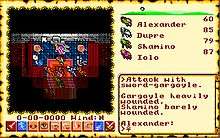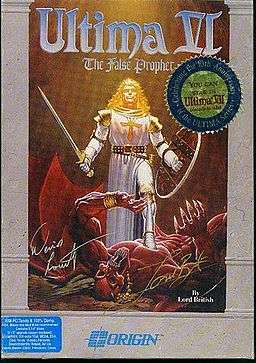Ultima VI: The False Prophet
| Ultima VI: The False Prophet | |
|---|---|
|
Cover art | |
| Developer(s) | Origin Systems |
| Publisher(s) | Origin Systems |
| Designer(s) |
Richard Garriott Warren Spector |
| Programmer(s) |
Herman Miller[1] Cheryl Chen[1] |
| Composer(s) |
Todd Porter Herman Miller |
| Series | Ultima |
| Engine | Ultima VI Engine |
| Platform(s) | DOS, Amiga, Atari ST, Commodore 64, FM Towns, Super NES, PC-9801, X68000 |
| Release date(s) |
June 1, 1990 (PC) 1993 (SNES) |
| Genre(s) | Role-playing video game |
| Mode(s) | Single player |
Ultima VI: The False Prophet, released by Origin Systems in 1990, is the sixth part in the role-playing video game series of Ultima. It was the last in the "Age of Enlightenment" trilogy.
Plot

Some years after Lord British has returned to power, the Avatar is captured and tied on a sacrificial altar, about to be sacrificed by red demon-like creatures, the gargoyles. Three of the Avatar's companions, Shamino, Dupre and Iolo, suddenly appear, save the Avatar and collect the sacred text the gargoyle priest was holding.
The Avatar's party flees through a moongate to Castle Britannia, and three of the gargoyles follow. The game begins with the player fighting the gargoyles in Lord British's throne room. After the battle, the Avatar learns that the shrines of Virtue were captured by the gargoyles and he embarks on a quest to rescue Britannia from the invaders.
It is only later in the game that the Avatar learns that the whole situation looks rather different from the point of view of the gargoyles – indeed, they even have their own system of virtues.[2] The quest for victory over the gargoyles now turns into a quest for peace with them.
Gameplay
This game ended the use of multiple scales; in earlier games a town, castle, or dungeon would be represented as a single symbol on the world map, which then expanded into a full sub-map when entering the structure. In Ultima VI, the whole game uses a single scale, with towns and other places seamlessly integrated into the main map; dungeons are now also viewed from the same perspective as the rest of the game, rather than the first-person perspective used by Ultima I-V. The game kept the basic tile system and screen layout of the three preceding parts, but altered the look into a much more colourful and detailed oblique view, to take full advantage of the newly released VGA graphics cards for PCs. Non-player characters had their portraits shown when talked to, something that would not have been feasible on the classic 8-bit Apple II.
Development
The development of the Ultima series originated on the Apple II series and every game thus far had been developed primarily on that platform, but by 1990 the market for 8-bit computers in the US had nearly evaporated, so there was no Apple II version for the first time. In any case, the games were starting to outgrow the capabilities of 8-bit hardware. Origin reportedly attempted an Apple II port of Ultima VI, but gave up after deciding it was impossible. The game was ported to the Commodore 64, although not without trimming considerable elements including aesthetics (no portraits), but also gameplay (no horses, no working gems, reduced NPC dialogs, simplified quests, etc). Ultima VI is the largest commercially-released C64 game at an entire megabyte in size and spanning six double-sided 1541 disks.
The biggest change from earlier Ultima games was a new interface. Richard Garriott based the game's new icon-based point and click interface on Chris Roberts' 1988 action role-playing game Times of Lore, streamlining the commands into ten icons.[3] Garriott expressed annoyance at not having thought of it sooner, realizing that "it was clearly the way to have gone" for earlier games.[4] Another change was the world design, where no longer would towns and castles be represented by icons on the overworld map, but where everything in the game world is represented on the same 1024x1024 tile map, except for dungeons and smaller outdoor maps. The caverns and dungeons beneath the land were also no longer represented in first-person view, but changed to an overhead, oblique isometric view, like the rest of the game.[3] The software routines that governed every element of movement and combat was developed by 25 year-old Boston programmer Herman Miller, who previously wrote the IBM conversions of Ultima V and Times of Lore. The conversation system, the means by which the player talks with characters, was developed by 26 year-old Chinese programmer Cheryl Chen, who developed her own programming language for the game called UCS (Ultima VI conversation system).[1] Conversations with townspeople were no longer restricted in terms of length, compared to the limitations of earlier Ultima games.[3]
It was one of the first major PC games directly targeted to PC systems equipped with VGA graphics and a mouse, when the big gaming computer was still the Amiga. The game supported sound cards for music as well, which were not yet common when it was released. Other sound effects, such as the clashing of swords, magical zaps, or explosions, were still played through the PC speaker. The Amiga version was itself ported from the PC and due to a lack of reprogramming it was very slow and generally considered unplayable without accelerator card on a first- or second-generation Amiga.
A port of the game for FM Towns platform was made primarily for Japanese market.[5] This CD-ROM-based version included full speech in both English and Japanese. Remarkably, in this particular version voice acting was recorded at Origin, mostly by the people the characters were based on (with Richard Garriott as Lord British, Greg Dykes as Dupre, etc.), though not all personnel could be reached at the time of recording, so some substitutes were used.
The game came with a cloth map of Britannia and a Moonstone made from a black colored bit of glass. Slightly improved versions of the Ultima VI engine were also used for the Worlds of Ultima spin-off series.
Origin produced a deluxe edition of Ultima VI for sale by mail order at the same $69.95 price as the retail version. Lord British autographed the copies, which contained an audio interview with him, game hints, and higher-quality moonstone.[6]
The DOS version of Ultima VI may have sound and speed problems when running on modern computers and operating systems. However, it can run reliably in a DOSBox environment. An engine remake project called Nuvie,[7] similar to the goals of xu4, Exult.[8]
Reception
Scorpia of Computer Gaming World's in 1990 stated that she "had some profound, mixed feelings about" Ultima VI because of the changes to the user interface, graphics, and gameplay. The change to a single scale for the world, for example, greatly increased travel and exploration time; long quests had small rewards; and performance became sluggish with many characters on screen. She liked, however, the "solid story" that elegantly concluded the second trilogy, lack of pointless outdoor encounters, and improved NPC dialogues, and concluded that Ultima VI "is a very good game".[9] In 1993 she criticized the middle of the game and the hunt for the pirate map, but stated that it was "definitely worth your time".[10] Dragon gave the game 5 out of 5 stars,[11] but only 3 out of 5 stars for the Super NES version.[12]
In 1992, Computer Gaming World added Ultima VI to the magazine's Hall of Fame for games that readers highly rated over time.[13] In 1996 the magazine ranked it as the 44th best game of all time, stating: it "hit new heights in virtuality with the defined objects in the game world" and "also presented a brilliant treatise on the danger of prejudice."[14]
Fan remakes
A fan-made recreation of Ultima VI using the Dungeon Siege engine, The U6 Project (aka Archon), was released on 5 July 2010. Another remake project uses the Exult engine, using graphics from Ultima VII. Ultima 6 Online is an MMO version of Ultima VI.[15]
References
- 1 2 3 https://archive.org/stream/TheOfficialBookOfUltima/The-Official-Book-of-Ultima#page/n109/mode/2up
- ↑ See "Gargish Virtues" at the Ultima Codex
- 1 2 3 https://archive.org/stream/TheOfficialBookOfUltima/The-Official-Book-of-Ultima#page/n95/mode/2up
- ↑ https://archive.org/stream/Ultima_Guide_OfficialBookOfUltima#page/n67/mode/1up
- ↑ Description of the FM Towns version
- ↑ "Special Limited Edition Ultima VI Offer". Computer Gaming World. March 1990. p. 16. Retrieved 15 November 2013.
- ↑ Nuvie, open source project aiming to recreate the Ultima VI engine
- ↑ Exult remake discussion
- ↑ Scorpia (June 1990). "Ultima VI". Computer Gaming World. p. 11. Retrieved 16 November 2013.
- ↑ Scorpia (October 1993). "Scorpia's Magic Scroll Of Games". Computer Gaming World. pp. 34–50. Retrieved 25 March 2016.
- ↑ Lesser, Hartley; Lesser, Patricia; Lesser, Kirk (October 1990). "The Role of Computers". Dragon (162): 47–51.
- ↑ Petersen, Sandy (August 1994). "Eye of the Monitor". Dragon (208): 61–66.
- ↑ "The CGW Poll". Computer Gaming World. April 1992. p. 48. Retrieved 24 November 2013.
- ↑ "150 Best Games of All Time". Computer Gaming World. November 1996. pp. 64–80. Retrieved 25 March 2016.
- ↑ Ultima 6 Online Overview
External links
- Ultima VI: The False Prophet at MobyGames
- Ultima VI: The False Prophet can be played for free in the browser at the Internet Archive
